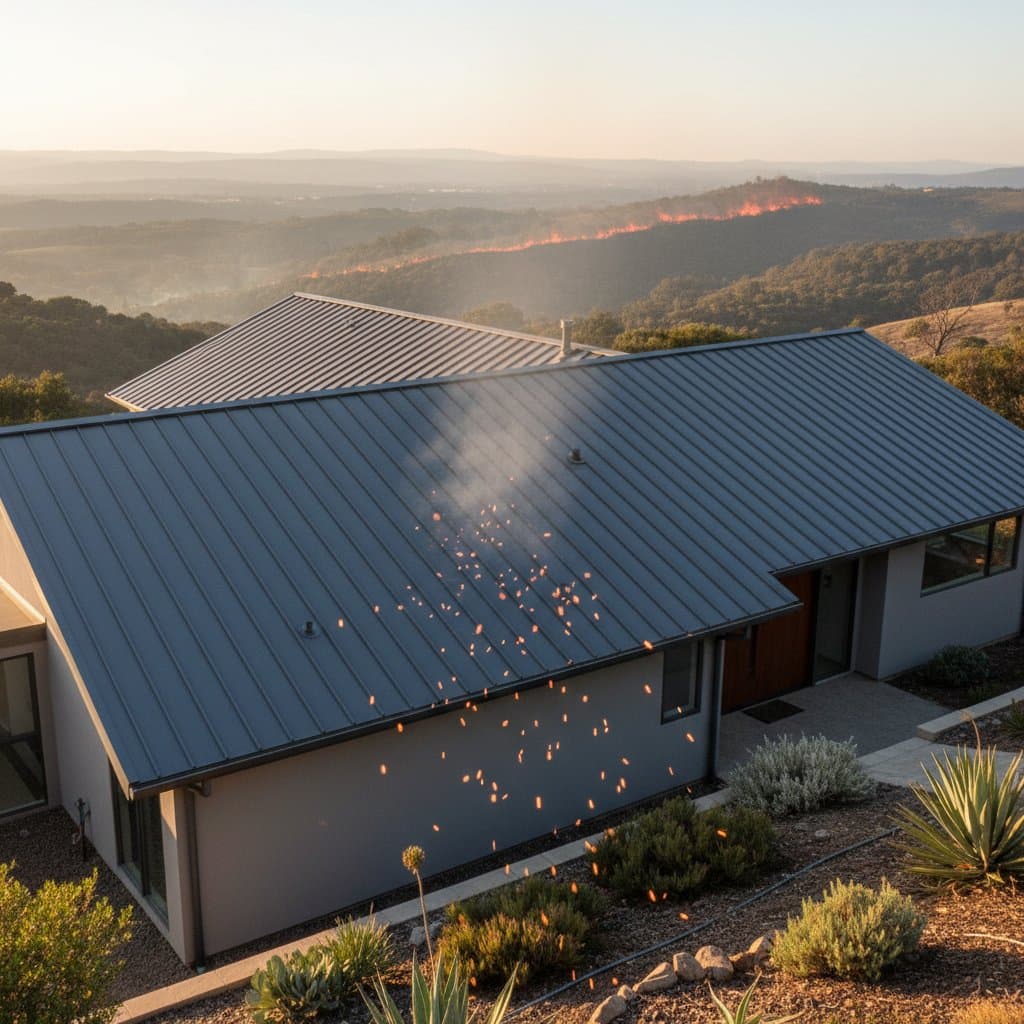New Ratings Highlight Metal Roofs' Strength Against Wildfire Embers
Homeowners in wildfire-vulnerable areas often worry about protecting their properties from distant threats. Embers, those small glowing particles carried by wind, pose a significant risk by igniting roofs and structures far from the main fire. Recent safety assessments now validate metal roofs as a leading solution, effectively preventing ember ignition and offering reliable defense.
These findings influence roofing decisions in dry, windy climates. For those evaluating roof replacements or new installations, grasping metal roofing's performance advantages supports informed choices for safety and durability.
Understanding Ember Threats
Flames draw attention during wildfires, yet embers cause the majority of structural damage. These particles, lightweight and airborne, can journey several miles ahead of advancing fires. Upon landing on combustible surfaces like asphalt shingles or accumulated debris, they ignite rapidly.
Common roofing options, including wood shakes and basic asphalt, burn readily. Minor imperfections, such as gaps around vents or edges, allow embers to infiltrate and smolder undetected. In fire-risk zones, selecting materials with proven ember resistance becomes essential for prevention.
Metal roofs stand out due to their non-combustible nature. Their smooth surfaces shed embers and dissipate heat, blocking penetration as confirmed by updated testing standards.
Earning High Fire-Resistance Scores
Testing protocols from safety bodies evaluate materials on ignition resistance, thermal conductivity, and ember deflection. Metal roofs achieve the top Class A rating, enduring direct flame exposure without combustion or subsurface fire spread.
Key attributes include non-flammable alloys like steel and aluminum, which avoid fueling blazes. Interlocking panels form seamless barriers, while heat-reflective coatings minimize surface temperatures and protect adjacent areas.
Verify Class A certification and pair it with non-combustible underlayment for optimal results. This combination ensures comprehensive protection tailored to regional codes.
Ensuring Effective Installation
Superior materials require precise installation to maximize benefits. Exposed seams or flammable accessories undermine performance, so hire certified professionals familiar with fire codes.
In high-risk locations, integrate ember screens over vents and seal perimeter edges with metal flashing. Regularly clear gutters to avoid debris buildup, which could otherwise trap and ignite embers.
For re-roofing projects, upgrade the full assembly with fire-rated insulation. This layer not only bolsters fire safety but also improves thermal regulation, maintaining comfortable indoor environments year-round.
Benefits of Enduring Protection
Beyond fire resistance, metal roofs withstand environmental stresses like severe weather and pests. They resist corrosion, impact from hail, and wind uplift, reducing the need for frequent interventions.
In recurrent wildfire areas, this longevity translates to sustained security over 40-70 years. Periodic inspections for secure fasteners and clean surfaces preserve these qualities, extending the roof's protective role.
Reflective finishes further cut energy demands by lowering attic heat, yielding savings on cooling bills alongside safety gains.
Balancing Aesthetics and Function
Concerns about appearance often deter metal roof adoption, but contemporary options dispel such notions. Available in profiles emulating clay tiles, cedar shakes, or standing seams, they blend seamlessly with diverse architectures.
Colors range from earthy tones to bold hues, coated for fade resistance and UV protection. This versatility complies with community standards while elevating property visuals and underscoring proactive safety measures.
Homeowners appreciate how these roofs enhance overall appeal, combining practicality with design harmony.
Weighing Investments and Returns
Initial costs for metal roofs exceed those of asphalt by 20-50 percent, yet lifetime economics favor them. Decreased repair frequency, potential insurance discounts in fire zones, and ember-proofing justify the outlay.
Energy-efficient properties reduce utility expenses, with some systems qualifying for rebates. Calculate total ownership costs, including warranties spanning decades, to appreciate the fiscal prudence.
Obtain multiple quotes from reputable installers, prioritizing those offering extended guarantees on materials and labor.
Integrating with Comprehensive Fire Strategies
A metal roof strengthens defenses but pairs best with holistic practices. Create a 30-foot defensible space by pruning overhanging branches and clearing ground fuels around the structure.
Opt for fiber-cement or stucco siding over wood, and install spark-arresting mesh on chimneys. Relocate combustible items like mulch piles or outdoor furniture away from walls.
Routine tasks, such as biannual roof sweeps and vegetation management, amplify effectiveness. These measures collectively minimize ignition risks from embers or advancing flames.
Building Resilience for the Future
Opting for a metal roof equips your home against evolving wildfire patterns. Its validated ember resistance safeguards investments and loved ones, fostering security in uncertain conditions.
This choice reflects foresight in material selection and upkeep. With strategic enhancements, your property emerges more robust, ready to endure environmental challenges while preserving comfort and value.
